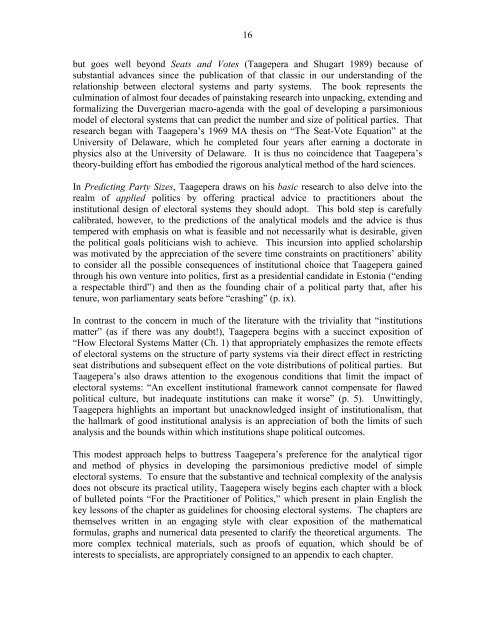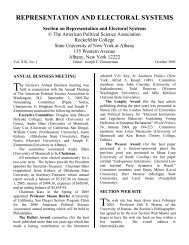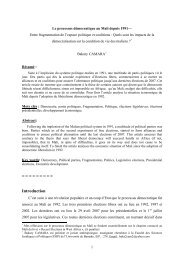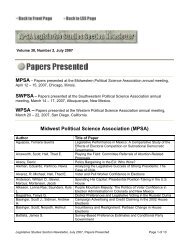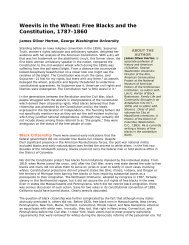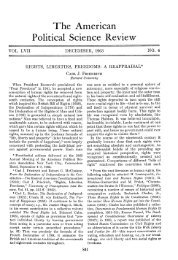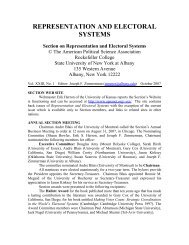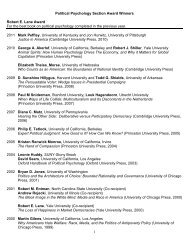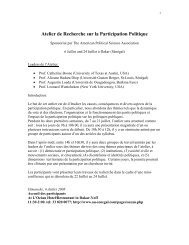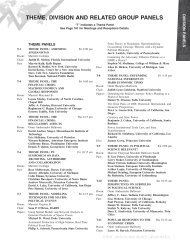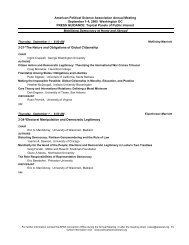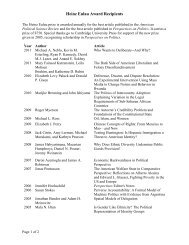representation and electoral systems - American Political Science ...
representation and electoral systems - American Political Science ...
representation and electoral systems - American Political Science ...
You also want an ePaper? Increase the reach of your titles
YUMPU automatically turns print PDFs into web optimized ePapers that Google loves.
16<br />
but goes well beyond Seats <strong>and</strong> Votes (Taagepera <strong>and</strong> Shugart 1989) because of<br />
substantial advances since the publication of that classic in our underst<strong>and</strong>ing of the<br />
relationship between <strong>electoral</strong> <strong>systems</strong> <strong>and</strong> party <strong>systems</strong>. The book represents the<br />
culmination of almost four decades of painstaking research into unpacking, extending <strong>and</strong><br />
formalizing the Duvergerian macro-agenda with the goal of developing a parsimonious<br />
model of <strong>electoral</strong> <strong>systems</strong> that can predict the number <strong>and</strong> size of political parties. That<br />
research began with Taagepera’s 1969 MA thesis on “The Seat-Vote Equation” at the<br />
University of Delaware, which he completed four years after earning a doctorate in<br />
physics also at the University of Delaware. It is thus no coincidence that Taagepera’s<br />
theory-building effort has embodied the rigorous analytical method of the hard sciences.<br />
In Predicting Party Sizes, Taagepera draws on his basic research to also delve into the<br />
realm of applied politics by offering practical advice to practitioners about the<br />
institutional design of <strong>electoral</strong> <strong>systems</strong> they should adopt. This bold step is carefully<br />
calibrated, however, to the predictions of the analytical models <strong>and</strong> the advice is thus<br />
tempered with emphasis on what is feasible <strong>and</strong> not necessarily what is desirable, given<br />
the political goals politicians wish to achieve. This incursion into applied scholarship<br />
was motivated by the appreciation of the severe time constraints on practitioners’ ability<br />
to consider all the possible consequences of institutional choice that Taagepera gained<br />
through his own venture into politics, first as a presidential c<strong>and</strong>idate in Estonia (“ending<br />
a respectable third”) <strong>and</strong> then as the founding chair of a political party that, after his<br />
tenure, won parliamentary seats before “crashing” (p. ix).<br />
In contrast to the concern in much of the literature with the triviality that “institutions<br />
matter” (as if there was any doubt!), Taagepera begins with a succinct exposition of<br />
“How Electoral Systems Matter (Ch. 1) that appropriately emphasizes the remote effects<br />
of <strong>electoral</strong> <strong>systems</strong> on the structure of party <strong>systems</strong> via their direct effect in restricting<br />
seat distributions <strong>and</strong> subsequent effect on the vote distributions of political parties. But<br />
Taagepera’s also draws attention to the exogenous conditions that limit the impact of<br />
<strong>electoral</strong> <strong>systems</strong>: “An excellent institutional framework cannot compensate for flawed<br />
political culture, but inadequate institutions can make it worse” (p. 5). Unwittingly,<br />
Taagepera highlights an important but unacknowledged insight of institutionalism, that<br />
the hallmark of good institutional analysis is an appreciation of both the limits of such<br />
analysis <strong>and</strong> the bounds within which institutions shape political outcomes.<br />
This modest approach helps to buttress Taagepera’s preference for the analytical rigor<br />
<strong>and</strong> method of physics in developing the parsimonious predictive model of simple<br />
<strong>electoral</strong> <strong>systems</strong>. To ensure that the substantive <strong>and</strong> technical complexity of the analysis<br />
does not obscure its practical utility, Taagepera wisely begins each chapter with a block<br />
of bulleted points “For the Practitioner of Politics,” which present in plain English the<br />
key lessons of the chapter as guidelines for choosing <strong>electoral</strong> <strong>systems</strong>. The chapters are<br />
themselves written in an engaging style with clear exposition of the mathematical<br />
formulas, graphs <strong>and</strong> numerical data presented to clarify the theoretical arguments. The<br />
more complex technical materials, such as proofs of equation, which should be of<br />
interests to specialists, are appropriately consigned to an appendix to each chapter.


